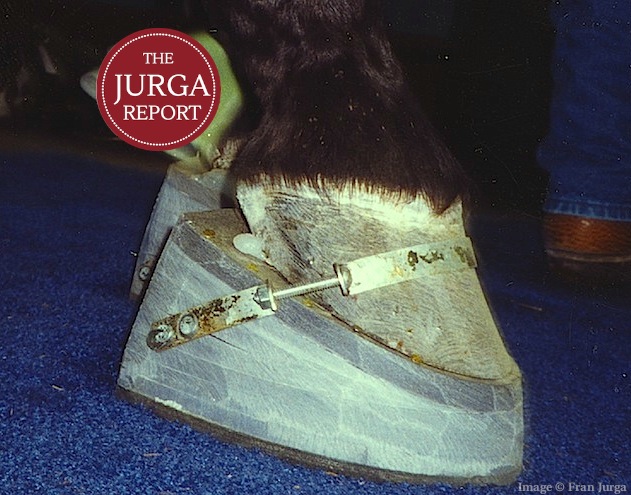
The United States Department of Agriculture is intent on enforcing the Horse Protection Act, which prohibits the soring of Tennessee Walking horses. Soring practices include chemical treatment of the horse’s pasterns and pressure shoeing.
Today the USDA sent a proposed rule change related to the enforcement of the Horse Protection Act directly to the agency’s higher authority: The White House. The Humane Society of the United States (HSUS) speculates (and hopes) that the USDA will request the authority to ban pad stacks.
Pad stacks are not technically part of soring. They are allowed equipment for Walking horses and are used by other breeds, such as Saddlebreds, Hackney ponies, Morgans and even Arabians under USEF rules. However, the stacks used by Walking horse trainers are extreme.
Stacks are used primarily to create the artificial “Big Lick” gait so carefully engineered by Walking horse trainers. Without pad stacks, there would be a great reduction in the exaggerated movement, and horses would be reduced to what their natural talent and shoeing within whatever latitude a new rule would allow.
While pad stacks are not technically illegal equipment in the soring paradigm, they can be abused. Many accusations have been made about added weight, such as lead, being concealed in cavities hollowed out in the stacks.
Another objection to pad stacks is that a horse can be trimmed very short before showing and then shod, so that each step is painful and the horse will snatch up its foot again from the pain. It’s not easy for inspectors to identify pressure shoeing.
HSUS has been an advocate of banning the stacks and pastern chains. According to a press release, in February 2015, the Washington-based organization filed a rulemaking petition with the USDA “to promulgate a rule to ban (them) in the Tennessee walking, spotted saddle, and racking horse breeds; put an end to the failed system of industry self-policing; and crack down on violations by extending disqualification periods for both the offender and the sored horse.”
But HSUS isn’t alone in calling for the so-called “action device” ban. Back in 2008, the American Association of Equine Practitioners (AAEP) published a white paper stating its position on Walking horse soring. “Putting the Horse First: Veterinary Recommendations for Ending the Soring of Tennessee Walking Horses” is a seven-page statement on that organizations interpretation of how soring practices effect the welfare and well-bring of the horse.
With their support of the proposed Prevent All Soring Tactics legislation (“PAST Act”) in Congress, the AAEP and the American Veterinary Medical Association (AVMA) implied endorsement of a ban on action devices, as outlined in that legislation.
In a 2012 statement, the AVMA shared this analysis of action devices (pads and chains):
“As regards chains and pads, the industry says “there’s no science to suggest that chains and pads cause problems.” What the science says is that raising the heels (placing a horse on pads and wedges) 8 degrees can cause the horse to stumble and tire easily.
“Additionally, horses placed on pads and wedges showed inflammation in the flexor tendon area of the pastern. Chains that weigh 6 ounces will start to cause hair loss without the use of chemical irritants. Chains heavier than 6 ounces used on horses that have been previously sored will cause open lesions within two weeks.
“We’re happy to say we did our homework and, yes, the science that’s available appears to support our position. However, the industry has (once again) missed the point of the AVMA’s and AAEP’s decision. The AVMA’s and AAEP’s primary concern is that chains and pads are used to exacerbate and/or hide soring. And they can do so irrespective of their size and/or weight. And, if you had any question about whether we’re really talking about 6-ounce chains and small “packages” (as suggested by the industry) our photos that were provided by an AAEP member should resolve them.
“To remove opportunity and incentive to sore, and to facilitate the inspection process under the HPA, the AVMA and AAEP agree with the authors of HR 6388 that self-policing, and chains and pads, have to go.”
The AAEP’s latest position statement on soring, reviewed by the AAEP Board of Directors in 2016, renews the organization’s interest in ending the soring of Walking horses.
As HSUS reminded us today, “It’s been a federal crime since 1970 to show horses who have been sored – subjected to the intentional infliction of pain on their legs and hooves to force them to step higher to gain a competitive edge in the show ring.” That’s 46 years that a federal agency has failed to end a cruel process it was mandated by Congress to eliminate.
What was in the package sent for approval (via the Office of Management and Budget) in hopes of executive action? And will it be endorsed to move forward?
This article will be updated as soon as the proposed rule change is revealed.








